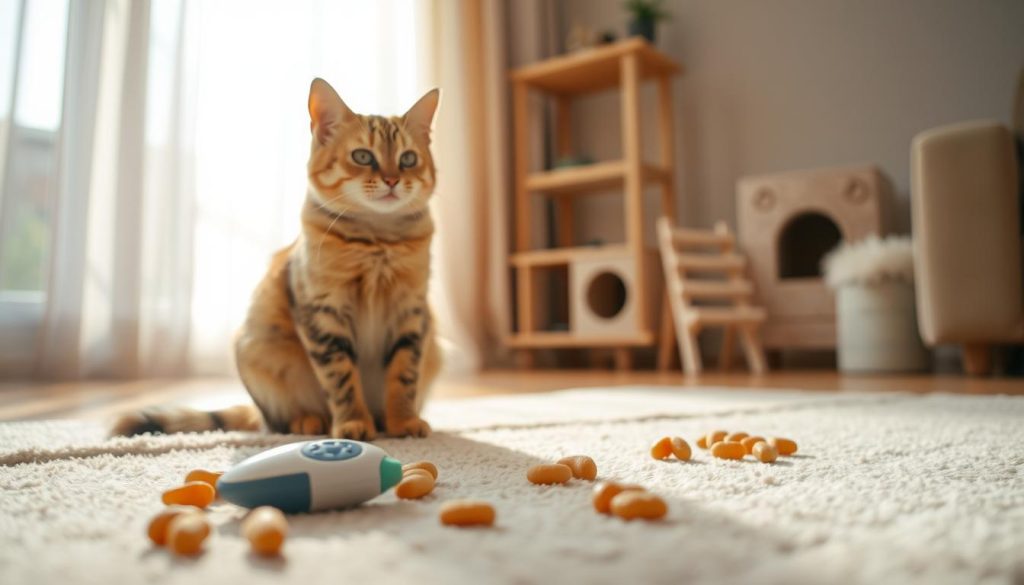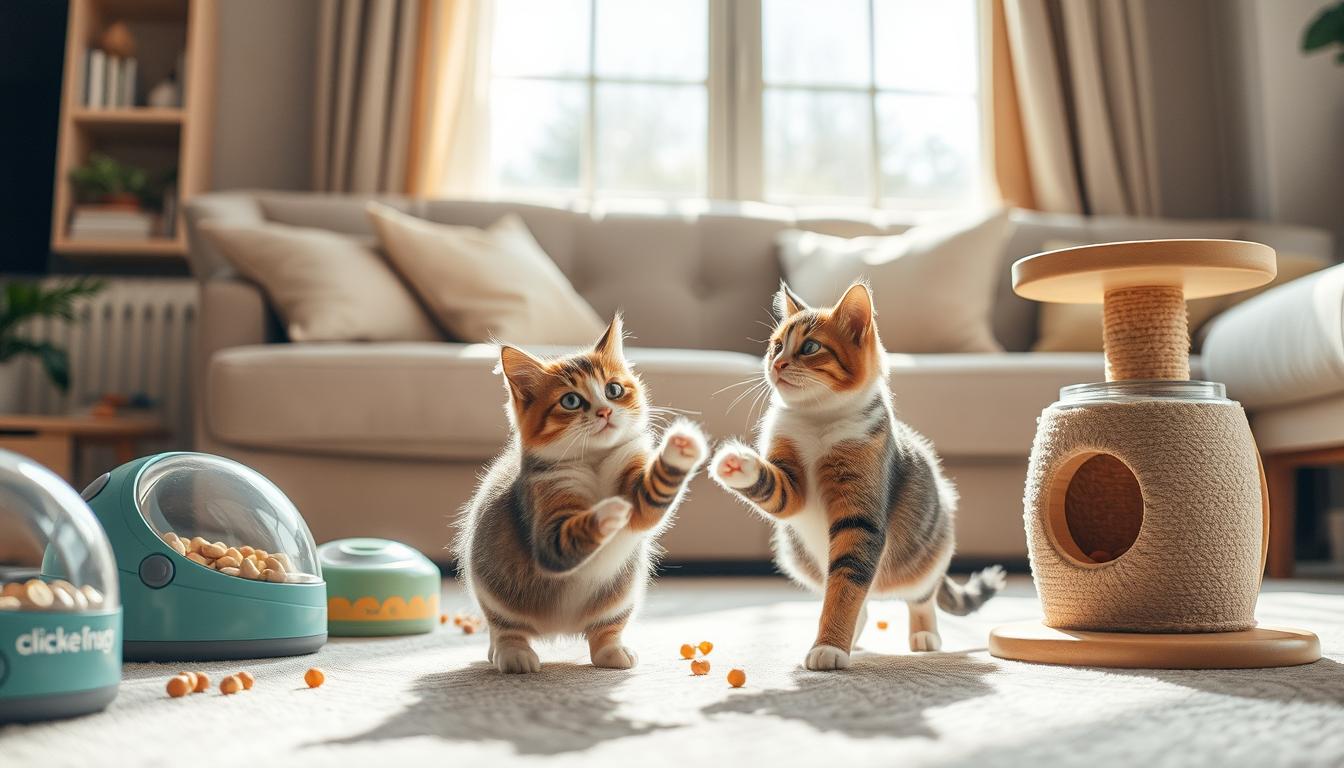As a dedicated cat owner, I know how vital it is to support our feline friends’ natural behaviors. This guide will show you how to modify your cat’s behavior. We’ll tackle issues like scratching furniture and litter box problems with positive methods.
Understanding your cat’s behavior can greatly improve their life and your bond with them. We’ll dive into reading their body language and adding fun enrichment activities. This will help you become a better cat parent and make your home a happy place for your cat.
Understanding Cat Behavior
Understanding your cat’s behavior is crucial for their happiness. By knowing their body language, we can see how they feel. Each small sign, like ear position or tail movement, tells us a lot.
Decoding Feline Body Language
Watching your cat’s body language helps you understand them better. Here are some key signs to look for:
- Ears forward and upright – Shows they’re interested or paying attention
- Ears laid back – Means they’re scared, upset, or feeling aggressive
- Tail held high and twitching – Shows they’re confident and curious
- Tail tucked beneath the body – Means they’re anxious or feeling submissive
Environmental Influences on Cat Behavior
The place where a cat lives greatly affects their behavior. Things like lighting, smells, and family interactions play a big role. Knowing these factors helps us create a better home for our cats.

Exploring cat behavior and its environment helps us connect better with them. This knowledge is key to making our cats happier and healthier.
Positive Reinforcement Techniques
Positive reinforcement is a great way to change cat behavior. We use treats, praise, and rewards to encourage good habits. This method is fun for cats and their owners.
Clicker Training for Cats
Clicker training is a powerful tool. The “click” sound tells the cat they did something right. It helps us teach new tricks or stop bad habits.
Positive reinforcement helps us bond with our cats. It makes learning fun and engaging. With patience, your cat can learn a lot.

| Technique | Description | Benefits |
|---|---|---|
| Positive Reinforcement | Rewarding desirable behaviors with treats, praise, or other rewards | Builds a positive association, strengthens the bond, and shapes behavior effectively |
| Clicker Training | Using a clicker device to mark the exact moment of a desired behavior | Provides a clear communication tool, allows for precise shaping of new behaviors |
Addressing Common Behavioral Issues
As a cat owner, I’ve faced many feline behavioral challenges. One big issue is cats scratching furniture, a natural act that can harm our homes. But, with the right steps, we can guide our cats to scratch where they should and save our furniture.
Scratching Furniture: Redirecting the Behavior
Understanding why cats scratch is key to solving this problem. They scratch to shed their nails, mark their territory, and stretch. By giving them the right places to scratch, we can keep our furniture safe.
- Invest in sturdy scratching posts or pads: Place these around the house, making sure they’re tall enough for your cat to stretch and scratch.
- Encourage use with catnip or feather toys: Sprinkle catnip on the scratching surfaces to attract your cat and encourage the right behavior.
- Clip your cat’s nails regularly: This makes their nails shorter and less sharp, reducing damage from scratching.
- Use deterrents on furniture: Apply citrus-scented products or double-sided sticky tape to stop your cat from scratching the furniture.
By tackling the reasons behind scratching and offering the right places to scratch, you can redirect your cat’s scratching behavior and prevent furniture damage. This way, you can also address common cat behavior problems.
Cat Behavioral Modification
Changing a cat’s behavior takes patience, consistency, and understanding of their psychology. As a professional copywriter, I’ve found that gradual changes, clear boundaries, and positive rewards are key. These methods help address issues or improve your cat’s life.
Cats are creatures of habit and can resist change. So, introducing new behaviors slowly is crucial. This helps your cat adjust without feeling stressed or overwhelmed.
Setting clear boundaries and expectations is also vital. Cats love routine and predictability. By setting consistent rules and rewarding good behavior, you can shape their habits for the better.
Positive reinforcement is at the heart of successful cat behavior change. Instead of punishing bad behavior, reward the good. Use treats, praise, or playtime to motivate your cat.
Remember, patience is essential in changing a cat’s behavior. It may take time and effort. But with these principles, you can help your cat develop positive habits that improve their life and your bond.

Creating a Stimulating Environment
It’s key to make your cat’s life better by creating a fun and engaging space. By meeting their natural needs, you can lower stress and bad behaviors. This makes your home a better place for both you and your cat.
Enrichment Activities for Indoor Cats
Cats love to explore, and indoor cats might miss out on outdoor fun. To fix this, add fun activities that match their curiosity and need for movement. Here are some ways to make your indoor cat’s life more exciting:
- Install vertical scratching posts and platforms to encourage natural scratching and climbing behaviors.
- Provide interactive toys, such as puzzle feeders, treat-dispensing balls, and dangling toys, to engage your cat’s hunting instincts.
- Establish cozy and elevated resting spots, allowing your cat to survey their territory from a safe and comfortable vantage point.
- Rotate and introduce new toys regularly to keep your cat’s interest piqued and prevent boredom.
- Engage your cat in regular play sessions, using wand toys or laser pointers to encourage physical activity and mental stimulation.
Adding these fun activities can make your cat happier and healthier. A happy cat is a well-stimulated cat!
Managing Stress and Anxiety in Cats
Cats are very sensitive, and their emotional health is as important as their physical health. Stress and anxiety can make cats act differently. They might groom too much, eat less, or have trouble with the litter box. It’s key for pet owners to know how to spot and handle these issues to keep their cats happy and secure.
Using calming pheromones is a good way to reduce stress in cats. These are natural or synthetic substances that calm a cat’s nerves. By using pheromone diffusers or sprays in your home, you can make your cat feel more relaxed and less anxious.
Creating a regular routine is also helpful. Having set times for meals, play, and grooming makes your cat feel secure. This is especially good for cats that get anxious or are very sensitive.
Adding fun toys, scratching posts, and places to hide can also help. These things give your cat ways to express themselves naturally. This can help prevent boredom and frustration, which can lead to stress and anxiety.
Every cat is different, so what works for one might not work for another. It’s important to watch how your cat acts and what they like. With patience and understanding, you can make your cat’s life better and happier.
Introducing New Pets or Family Members
Bringing a new pet or family member home is exciting. But, it can stress out your cat. Cats don’t like change and may need time to get used to a new person or pet. Slowly introducing them can help your cat feel more comfortable and build a good relationship.
Gradual Socialization Strategies
Start by letting your cat and the new person or pet get used to each other’s smell. Swap their bedding or items they’ve used. This helps your cat feel less scared and more comfortable with the new presence.
Then, have short, supervised meetings between your cat and the newcomer. Start with short times and slowly make them longer. Make sure your cat has a safe place to go if they feel too stressed. Give them treats or playtime to make the new person a positive experience.
Remember, getting used to a new person or pet takes time. Make your home welcoming and stress-free. This will help your cat adjust and build a good bond with the newcomer.

